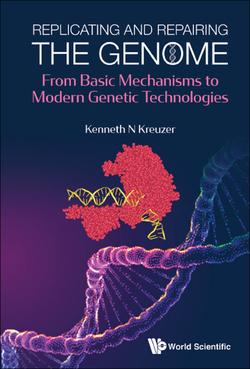Читать книгу Replicating And Repairing The Genome: From Basic Mechanisms To Modern Genetic Technologies - Kenneth N Kreuzer - Страница 39
На сайте Литреса книга снята с продажи.
How did they test that?
Does the sliding clamp encircle DNA?
ОглавлениеStukenberg et al. (1991) analyzed the mechanism by which E. coli sliding clamp stimulates DNA polymerase. One approach was to ask about the nature of clamp binding to DNA. They loaded radioactive clamps onto (nicked) duplex circular DNA, subjected the mixture to various manipulations, and then analyzed the samples with gel-filtration columns. In these columns, large intact protein-DNA complexes elute in the early fractions (around fraction 15), while smaller unbound proteins elute later (fractions 25–35). Previous experiments verified these elution positions. In panel A, radioactive clamp protein is found to be free in solution if the DNA is cleaved with restriction enzyme SmaI prior to the column (filled triangles), but still bound to DNA without restriction enzyme (filled circles).4 In panel B, clamp was retained on circular DNA even if ATP and the clamp loader (γ complex) were removed; however, clamp again fell off the DNA if the DNA was cleaved with a (different) restriction enzyme. In panel C, clamp remained bound to circular DNA when the DNA nick was sealed with DNA ligase, showing that the clamp does not need a nick to remain bound. Panel D showed that multiple clamps (roughly 20) can be loaded onto DNA; DNA cleavage with SmaI released the loaded clamps. The data in panel E are remarkable. DNA-binding protein EBNA1 was bound in two locations to the loaded clamp–DNA complex, and then the DNA was cleaved in between. Now, the clamp no longer dissociated when the DNA was linearized, showing that another bound protein can block the clamp from sliding off the ends of linearized DNA! (The insert gel shows that the restriction enzyme did indeed cleave the DNA.) These experiments provided strong evidence that clamp encircles DNA, and later crystal structures showed that the clamp is shaped like a donut with a hole that can accommodate duplex DNA. The figure was reproduced from Stukenberg et al. (1991), with permission from the American Society of Biochemistry and Molecular Biology; permission conveyed by Copyright Clearance Center, Inc.
1Some evidence suggests that the functioning Escherichia coli holoenzyme contains three copies of DNA polymerase, including a spare like the one discussed in the T7 replisome in the previous chapter, but this point is still controversial.
2We will discuss an exception in the section below on replication restart.
3The resulting enzyme free of 5′ to 3′ exonuclease activity, called “Klenow enzyme,” has been used extensively in biotechnology and DNA manipulation in vitro.
4Only a subset of clamp is loaded onto DNA, explaining the peak in the unboundprotein fractions. The dimeric Escherichia coli clamp is named β, explaining the axis label.
